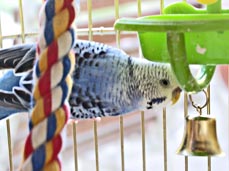
Always get the best cage you can afford. If you’re shocked at the prices, and tempted to get the cheapest one in the store just to save a few bucks, ask yourself if you’re really ready to buy a bird and give it a good home.
Parrots Cage-Choosing a Size
The cage should be spacious enough to allow the exercise and play it needs to be happy and healthy. No cage is too big—parrots, like all birds, love open spaces and would be more than happy for a little extra wing room. But a cage that’s too small is a sure step towards disaster. Your pet may become depressed, and can resort to negative behavior like feather plucking or other forms of self-mutilation. At the very least, it will not be able to move around, and can become weak, lazy and overweight.
Parrots Cage-Choosing a Shape
Cages come in many shapes and forms. Most parrot enthusiasts say that it’s best to get a square or rectangular one. The birds like having a corner where they can hide when they feel threatened or overwhelmed. (In fact, you should place the cage against a wall, to make them feel even more secure.)
Round cages, on the other hand, are the domestic equivalent of being trapped in an open field. The parrots always are on the look out for potential threats, and they may develop a very nervous or aggressive temperament.
Parrots Cage- Choosing a Material
Most bird enthusiasts recommend a stainless steel cage. Other materials can contain metals that are potentially toxic. Zinc, for example, has proven to be deadly to birds. Also avoid wooden cages, which are difficult to clean, and can splinter when chewed (and parrots love to chew!). You should also wash a new cage to remove any trace chemicals.
Parrots Cage-Other considerations
For your convenience, pick a cage that has an opening that is larger than the bird at its adult length. That way you won’t risk hurting it each time you take it out—feathers can catch on sharp edges, or it may trigger the latch as it struggles to squeeze through a cramped door and get pinched in the process.
Look for a cage that has a removable tray, so you can easily dispose of any droppings or stray bits of food. Some owners take out the grid that separates the tray from the rest of the cage, to let the parrots scavenge for food. Don’t do this. You don’t want your pet picking at feces, or accidentally getting some of it into its feathers. It’s filthy, and potentially toxic.